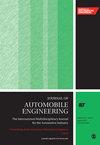利用倾斜技术对车辆轨迹跟踪进行非线性模型预测控制
IF 1.5
4区 工程技术
Q3 ENGINEERING, MECHANICAL
Proceedings of the Institution of Mechanical Engineers Part D-Journal of Automobile Engineering
Pub Date : 2024-08-02
DOI:10.1177/09544070241266285
引用次数: 0
摘要
为了提高高速自动驾驶车辆的轨迹跟踪性能,本文采用了一种控制车身向曲线内侧倾斜的新技术,即 "倾斜技术"。它通过主动悬挂系统实现这种倾斜,使车身向弯道内侧倾斜,从而减少或抵消重力产生的扭矩和离心力产生的扭矩。这大大提高了车辆的操控稳定性和防侧翻能力。将这项技术与主动转向控制相结合,设计出了一种非线性模型预测轨迹跟踪控制器。该集成控制器使用 Fiala 轮胎侧向力模型来建立具有转向-滚动动力学的非线性车辆模型,同时设计了双线变化和单线变化测试作为参考路径。为避免车身倾斜角过大而超过悬挂系统的有效行程,采用了理想倾斜角作为理想倾斜角。仿真验证证实了集成轨迹跟踪控制的有效性。将所提出的控制器与其他两种轨迹跟踪控制器(以零滚动角为控制目标的控制器和无滚动控制的控制器)进行了比较。结果表明,与后两者相比,所提出的轨迹跟踪控制器能确保良好的跟踪能力,同时有效提高高速无人驾驶车辆在轨迹跟踪过程中的操纵稳定性、防侧翻能力和乘员横向乘坐舒适性。本文章由计算机程序翻译,如有差异,请以英文原文为准。
Nonlinear model predictive control of vehicle trajectory tracking using tilting technology
To enhance the performance of trajectory tracking in high-speed autonomous vehicles, this paper adopts a new technology for controlling the vehicle body to tilt toward the inside of a curve, known as “tilting technology.” It achieves this tilt through an active suspension system that inclines the vehicle body toward the inside of the curve, thereby reducing or offsetting the torque generated by gravity with the torque produced by centrifugal force. This significantly improves the vehicle’s handling stability and anti-rollover capability. Integrating this technology with active steering control, a nonlinear model predictive trajectory tracking controller has been designed. For this integrated controller, the Fiala lateral tire force model is used to establish a nonlinear vehicle model with steering-rolling dynamics, while a double-lane-change and single-lane-change tests are designed as the reference paths. To avoid the tilting angle of the vehicle body being too large to exceed the effective stroke of the suspension, a clipped ideal tilt angle is adopted as the desired tilting angle. Simulation verification is carried out to confirm the validity of the integrated trajectory tracking control. The proposed controller is compared with two other trajectory tracking controllers, the controller that takes zero rolling angle as the control target and the controller without rolling control. The results show that, compared with the latter two, the proposed trajectory tracking controller can ensure well tracking ability, meanwhile effectively improving the handling stability, anti-rollover capability, and occupant lateral ride comfort during trajectory tracking for high-speed unmanned vehicles.
求助全文
通过发布文献求助,成功后即可免费获取论文全文。
去求助
来源期刊

CiteScore
4.40
自引率
17.60%
发文量
263
审稿时长
3.5 months
期刊介绍:
The Journal of Automobile Engineering is an established, high quality multi-disciplinary journal which publishes the very best peer-reviewed science and engineering in the field.
 求助内容:
求助内容: 应助结果提醒方式:
应助结果提醒方式:


